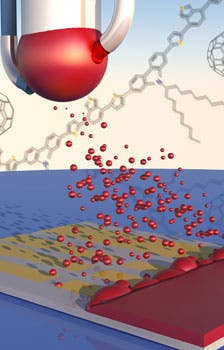Solar cells don’t necessarily come in bulky, sandwich panels you see hang up most roofs. There are a myriad of solutions at your disposal: thin or ultrathin cells, organic cells, flexible cells, you name it. Perhaps the most versatile option, in theory at least, is a spray-on solar cell. Image having a solar cell active solution in a can. You can then turn virtually any surface fitted with electrodes into a solar power source. It’s really amazing, but what it makes in ingenuity, it lacks in efficiency. Researchers at University of Sheffield aim to change all this, after they report they’ve for the first time developed perovskite solar cells using a spray-on process. The resulting cells are efficient and affordable.
Solar power in a can

A while ago, I wrote a bit about how perovskite might significantly boost the solar power market. Discovered for its solar power conversion capabilities just a couple of years ago, research into perovskite solar cells have so far rendered fantastic results. In just a couple of years, rated efficiency has jumped from 3.8% to over 19%. Cheap, readily available and easy to make, perovskite is regarded as a viable candidate for complementing or replacing silicon at the helm of solar cell materials, because it takes less energy to make. Currently silicon solar cells, the mainstream type, have a rated efficiency of over 25%.
Paint-on or spray-on solar cells aren’t exactly new. Either using quantum dots or some other kind of solutions, spray-on solar cells have been very interesting to watch, but not that interesting to use. Expensive and with a low efficiency, they showed little practical use apart from show and tell. Experts at University of Sheffield have now developed spray-painting method to produce solar cells using perovskite.
Lead researcher Professor David Lidzey said: “There is a lot of excitement around perovskite based photovoltaics.”
“Remarkably, this class of material offers the potential to combine the high performance of mature solar cell technologies with the low embedded energy costs of production of organic photovoltaics.”
Previously, the researchers demonstrated a spray-on manufacturing process for organic semiconductors. Adapting the process, the researchers created devices with a perovskite absorber instead of an organic absorber, and reached much higher efficiency – around 11%. This is huge, considering no spray-on method has led to cells topping two figures in efficiency.
Professor Lidzey said: “This study advances existing work where the perovskite layer has been deposited from solution using laboratory scale techniques. It’s a significant step towards efficient, low-cost solar cell devices made using high volume roll-to-roll processing methods.”
Solar power is becoming an incr
Findings appeared in the journal Energy & Environmental Science.


